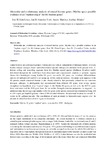Molecular and evolutionary analysis of mussel histone genes ("Mytilus" spp.): possible evidence of an "orphon origin" for H1 histone genes

View/
Use this link to cite
http://hdl.handle.net/2183/22492Collections
- Investigación (FCIE) [1228]
Metadata
Show full item recordTitle
Molecular and evolutionary analysis of mussel histone genes ("Mytilus" spp.): possible evidence of an "orphon origin" for H1 histone genesDate
2002-09Citation
Eirín-López, J., González-Tizón, A., Martinez, A. et al. J Mol Evol (2002) 55: 272. https://doi.org/10.1007/s00239-002-2325-1
Abstract
[Abstract:] Linker histones are a divergent group of histone proteins with an independent evolutionary history in which, besides somatic subtypes, tissue- and differentiation-specific subtypes are included. In the present work H1 histone coding and noncoding segments from five Mytilus mussel species (Mollusca: Bivalvia) widely distributed throughout the world have been determined and characterized. Analysis of promoter regions shows clear homologies among Mytilus H1 genes, sea urchin H1 genes, and vertebrate differentiation-specific H1 subtypes (H5 and H10), all having an H4 box motif in common. The amino acid sequence of the H1 protein central conserved domain is also closely related to that previously defined for the vertebrate divergent subtypes. A phylogenetic tree reconstructed from different H1 genes from several species strengthens the hypothesis of an “orphon” origin for the Mytilus H1 genes, as well as for the H10/H5 genes from vertebrates and the H1D gene from the sea urchin Strongylocentrotus purpuratus, is suggested. As additional data, the average copy number of the H1 genes in the species analyzed was estimated as being 100 to 110 copies per haploid genome, where FISH revealed telomeric chromosomal location for several H1 copies in M. galloprovincialis. The contribution of such proximity to heterochromatic regions over the amount of codon bias detected for H1 genes is discussed.
Keywords
Mytilus
H1 genes
Orphon genes
Copy number
FISH (Fluorescence in situ hybridization)
Phylogeny
H1 genes
Orphon genes
Copy number
FISH (Fluorescence in situ hybridization)
Phylogeny
Editor version
ISSN
0022-2844





